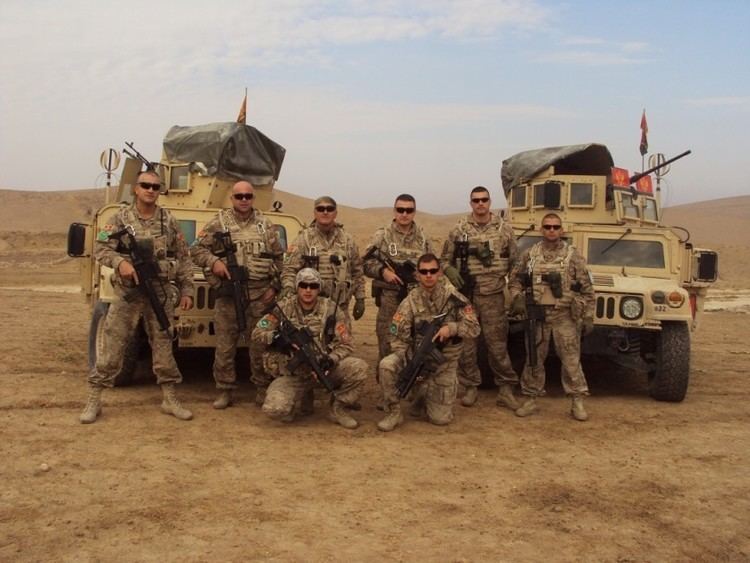Headquarters Podgorica Minister of Defence Predrag Bošković | President Filip Vujanović | |
 | ||
Founded 1879 (reconstituted 2006) Service branches Montenegrin Ground Army
Montenegrin Navy
Montenegrin Air Force Chief of Staff Lieutenant general Ljubiša Jokić | ||
The Military of Montenegro (Montenegrin: Vojska Crne Gore) consists of an army, navy and air force. There has been no conscription in Montenegro; the military is a fully professional standing army.
Contents
- Peacekeeping operations
- Leadership
- Ministry of Defense
- Air Bases
- Naval Bases
- Army Bases
- Units Structure
- Ranks and insignia
- The Military before 1918
- Formations and ranks
- References
The military currently maintains a force of 1,950 active duty members. The bulk of its equipment and forces were inherited from the military of Serbia and Montenegro; as Montenegro contained the entire coastline of the former union, it retained practically the entire naval force.
Montenegro is a member of NATO's Partnership for Peace program and is an official candidate for full membership in the alliance. Montenegro applied for a Membership Action Plan on 5 November 2008, which was granted in December 2009. In 2015, it was reported that international support for Montenegro's NATO membership was growing.
In December 2015, North Atlantic Council, invited Montenegro to join NATO as 29th member.
Peacekeeping operations
Montenegro participates in peace operations under the NATO and UN auspices as military troops and observers. Minister of Defense said that 85 soldiers are trained for international missions. Montenegrin soldiers are trained by the German Bundeswehr.
Montenegro sent 45 troops and medical personnel to the ISAF mission in Afghanistan, and continues contributing in new Resolute Support Mission mission.
Montenegro also participates in UN peacekeeping missions in Liberia, UNMIL, Cyprus, UNFICYP as military observers and Somalia, EU-NAVFOR.
Leadership
Ministry of Defense
Air Bases
Golubovci Airbase (Podgorica)
Naval Bases
Bar Naval base (Bar)
"Pero Ćetković" base (Bar)
Pristan base (Herceg Novi)
Army Bases
Army base "Milovan Šaranović" (Danilovgrad)
Army base "13 jul", Nikšić (Nikšić)
Army base "V. K. Volođa" (Pljevlja)
Army base "Breza" (Kolašin)
Units & Structure
Ranks and insignia
Enlisted rank insignia
Ground Army and Aifrorce Officer rank insignia
Navy Officer rank insignia
The Military before 1918
After military successes in the wars 1876-1878 during which the Principality of Montenegro was enlarged by a large territory, from the Tara River in the north to the Adriatic Sea in the south (liberated towns Podgorica, Nikšić, Kolašin, Andrijevica, Bar and Ulcinj), reorganization in Montenegrin army was conducted in 1880. Each kapetanija (municipality) formed its reserve battalion. There were 42 battalions in total. Since 1881, regular military exercises were conducted.
Supreme Commander of the Montenegrin army was the monarch, Prince / King Nikola I. Operational command, organization and financial support of the Montenegrin army was entrusted to the Ministry of Defence, the department of the Government of the Principality / Kingdom of Montenegro.
General Staff of the Montenegrin army was part of the Ministry of Defence.
In 1882 first 14 Montenegrins were sent to officer schools abroad, particularly in Italy and Russia. In 1886, 10 of them completed their education and they become first trained officers in Montenegrin warrior history. These Montenegrin officers held courses in Podgorica, Nikšić and Cetinje.
In September 1895, the first permanent Infantry NCO school in Podgorica was opened, and the first NCOs got desečar rank. At the end of 1896, artillery officer school in Cetinje was established - the first Montenegrin officer school.
Formations and ranks
In 1906 Montenegrin army received the first systematized regulations, and the Law on Organization of the Army was adopted in 1910. Infantry and artillery, were established, followed by two specialized branches (reconnaissance and pioneering), and additional branches (medics, military workshop, the military court staff, gendarmerie and logistics).
In 1913 the Montenegrin gendarmerie become a special Military Police unit.
Since the establishment of the internal Montenegrin telecommunications system in 1869, vital for the flow of military-defense information, it was under the jurisdiction of Ministry of the military.
Until 1912, the territory of the Kingdom of Montenegro was divided into four divisional areas:
After wars 1912th-1913th established additional two divisions field:
By 1912, the Montenegrin Army had 11 brigade areas, 52 districts and 322 battalion troop areas. Divisions were composed of 2-3 Infantry Brigade.
Each divisional command had three artillery batteries. On the eve of the First Balkan War Kingdom of Montenegro lined up 55,000 soldiers.
All Montenegrins between 18 and 62 years were conscripts. Recruitment was done three times a year, and the recruits are in peacetime had to have at least 25 years.
After the establishment of the Kingdom of Montenegro in 1910, Montenegro was involved in three wars with the first one being the First Balkan War, in alliance with Serbia, Greece, Romania, and Bulgaria against the Ottoman Empire. The Second Balkan War was fought between Montenegro, Serbia, Greece, Romania and the Ottoman Empire against Bulgaria, with Bulgaria consequently losing significant territory in the north, Thrace, and Macedonia.
The Military of Montenegro before 1918, was much larger than today's military. During World War I, Montenegro mobilised 50,000 troops. The Commander-in-Chief was King Nikola I of Montenegro, while the General of Staff was Božidar Janković. Units included:
The Pljevlja Division was commanded by brigadier Luka Gojnić. The division was made up of 10 battalions. It had around 6,000 soldiers, and patrolled the area east from Pljevlja.
The Herzegovina Detachment was commanded by Serdar (Count) Janko Vukotić. The detachment was made up of 15 battalions. It had around 15,000 soldiers, and patrolled the border with Herzegovina.
The Lovćen Detachment was commanded by divizijar Mitar Martinović. The detachment was made up of 18 battalions. It had around 8,000 soldiers, and patrolled the areas of Lovćen and Sutorman.
The 'Old Serbia' Detachment was commanded by brigadier Radomir Vešović. The detachment was made up of 13 battalions. It had around 6,000 soldiers, and secured the Albanian border.
